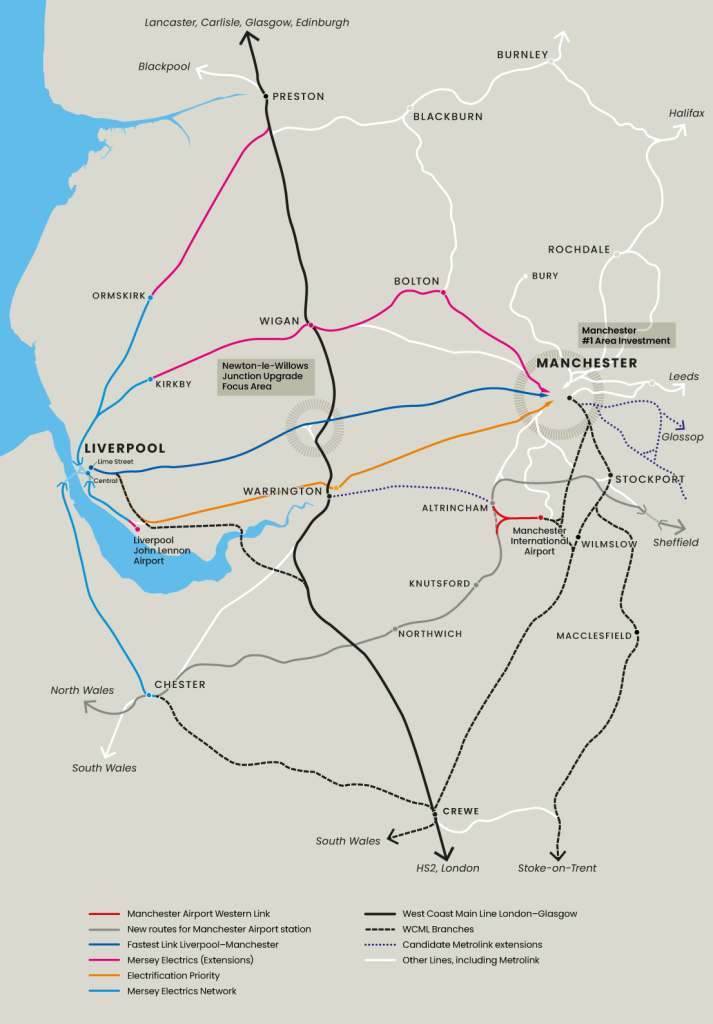On 29th January, Chancellor of the Exchequer Rachel Reeves announced transport investment plans: a third runway for Heathrow Airport, a second for Gatwick, and a new road tunnel the Lower Thames Crossing, near Dartford.
East West Rail was in there too, in support of the Oxford-Cambridge (Ox-Cam) Arc. It’s all in the south.
For the North – nothing.
Right now, HM Government sees rail investment as relevant when it supports economic growth, and international competitiveness. Treasury generally wants to back winners.
It didn’t take long for Liverpool University’s Heseltine Institute Professor Ian Wray to suggest what was needed was a North of England equivalent, a Northern Arc (Ref 1).
Ian Wray’s analysis was that an area including Liverpool, prosperous parts of Cheshire, and Manchester had characteristics similar to the ‘golden triangle’ (Oxford-Cambridge-London). It too deserves better rail connectivity, he argued. This isn’t old-school ‘levelling up’: this is investment in the strengths of the North. It’s about using rail investment to widen labour markets, build agglomeration economies and bring old industrial towns into the heart of the region.
But what type of investment in rail will further strengthen the economy of Wray’s ‘Northern Arc’? For Mayor Andy Burnham (and his near-neighbour, Mayor Steve Rotherham) the answer lies in a new Railway Board, established “to maximise the economic and social benefits of a new railway between the Liverpool City Region and Greater Manchester.”
This new line from Liverpool Lime Street would serve John Lennon Airport, Warrington, Manchester International Airport and reach Manchester Piccadilly using a tunnelled route previously planned for use by HS2. Mayor Burnham argues that £17bn was allocated to this project in 2023, when it was seen as part of ‘Northern Powerhouse Rail’.
But would this solve the main problem facing North West England’s rail network? No, the reality is it wouldn’t. It isn’t the rail links between the North’s great cities that are over-stretched; it’s where they meet up, in particular in the centre of Manchester.
Here, the network operates so close to capacity over so many unimproved junctions in close proximity to each other that it is a recipe, sadly but unsurprisingly, for poor train performance. It has recently been described by Rob McIntosh, Chair of the TransPennine Rail Upgrade project as “the big ugly Manchester question” (Ref 2).
Train services have had to be taken out of the timetable to restore a semblance of operational reliability. The Ordsall chord, which was to have formed the first part of a ‘Northern Hub’ scheme, was opened without planned wider supporting improvements that were very much needed.
A plan is lacking but needed on a regional scale
There is widespread evidence and agreement that strengthening the economies of cities like Manchester and Liverpool depends on (i) expanding their ‘commutable’ catchments (which are lower than in cities across Europe of equivalent scale) and (ii) improving access to other cities and airports, for business and trade.
The TransPennine Route Upgrade (TRU) is already delivering benefits. Liverpool-Manchester journey times are down to 34 minutes. A new, less direct route via Warrington and the two airports will not match that. And crucially, adding another radial line into the mix won’t solve Manchester’s central area network problems.
It is surely time to put in place a thorough examination of options for central Manchester, on a network basis, rather than off the back of a single new line proposal. Solutions are likely to be expensive and require tunnelling in the central area. We can learn from successes and failures of European cities that have faced similar challenges – Zurich, Stuttgart, and now Prague, for example, where major tunnelling/new station projects are under way or planned.
Of course, it’s not just central Manchester where improvement is needed. Short trains and low service frequencies for those travelling to work and to colleges and universities in northern England contrast strongly with the commuter experience in the South East, where if a train is cancelled or a service disrupted, there’s usually another way to complete the journey. So part of the answer is the ability to jump on connecting buses, or trams, to find another route. The Bee network initiated by Mayor Burnham is exactly what’s needed to help this required shift, spread across the wider North West in due course, with integrated ticketing across the (inter-connected) modes, creating a network out of a set of loosely inter-connected routes.
Along with inter-modal ticketing, train services can be much improved, and some options are shown below. This is a menu of possibilities which should be formulated into an updatable incremental delivery plan, and adopted in due course into the Government’s new 10-Year infrastructure Plan.

Produced by yellowfields.co.uk (not all lines are shown)
Three railways link Liverpool and Manchester
The original 1830 line (shown in blue) has been electrified (as part of the TRU project). True, there remain low-speed junctions in the Winwick/Earlestown/Newton-le-Willows/Golborne area that will need upgrades if new services are to be added.
To its north is the former L&Y route, but this, for through travellers, is severed at Kirkby, where passengers must disembark to join a connecting train. As can be seen, the opportunity to expand Merseyrail Electrics network, with its new, accessible, Class 777 train fleet arises not just here, but also for direct connections with Preston and with Liverpool John Lennon Airport (it already reaches Chester and Southport). The scope to support housing expansion plans – a key Government policy aim – is huge.
The CLC route via Warrington Central is shown in orange. Astonishingly, this route remains unelectrified. With the options emerging for use of hybrid battery-electric traction, this is another double-ended commuter route with huge potential, and where services could be intensified and accelerated.
Manchester
But the Number 1 area for investment is central Manchester as identified on the plan. Studies of what’s needed will need close collaboration with the city authorities because here major regeneration and development opportunities will arise. Understanding the continuing needs of railfreight will be important. The opportunity to extend the Metrolink tram system, with a long-standing ambition for new commuter routes to the south east, is another. Continuing speedy access to the city centre could be achieved in part by using existing railways rather than on-street running, just as happened with the original Bury-Altrincham scheme.
Also shown on the plan is a further candidate Metrolink route, to connect rail hubs in Warrington with Altrincham (and possibly Stockport, with tram or tram-train services), using a disused rail line and opening up further housing expansion possibilities that can avoid being ‘car-dependent’.
Manchester International Airport (MIA)
The (long-standing) possibility of a western rail link into MIA’s existing rail station is marked in red on the plan. This is of course all part of the ‘Northern Arc’ geography, and there are three reasons why this should be brought forward now:
- It would offer walk-in access to the airport terminals for rail users (in contrast with the possible NPR/HS2 station, which would lie to the west of the M56 motorway, and so need a bus shuttle)
- Converting the existing terminus station into a through station releases one of the critical operating bottlenecks affecting the central Manchester rail network
- It opens up valuable new direct rail access routes to the North’s major international airport, including from North Wales and from Sheffield, and these can be inter-connected to form valuable inter-regional routes.
Inter-regional connectivity
Elsewhere, the ‘Northern Arc’ has been presumed to have a wider geography. The recent ‘White Rose’ report from a grouping of Yorkshire authorities chaired by former home secretary Lord Blunkett, calls for a £14bn rail investment package. (Ref 3)
This is needed to ‘fix Yorkshire’s creaking Victorian-era” and is backed by the mayors of West, South and North Yorkshire. Lord Blunkett said the proposal offered “a once-in-a-lifetime opportunity” to improve connectivity and unlock economic growth in the region, and avoid being held back held back by ageing infrastructure, poor performance and unreliable trains.
Yorkshire’s Plan for Rail calls for increased capacity at Leeds, Sheffield and York stations, in recognition of the need to tackle the capacity and capability of the rail network ‘nodes’ as suggested here for Manchester. Fortunately, in these major Yorkshire cities, the investment needed is unlikely to be on the same scale as Manchester’s requirement. (Ref 4)
The crucial inter-regional transport link for North West England is to the West Midlands, the South East and London. Current commitments to build HS2 peter out in south Staffordshire. The West Coast Main Line through Colwich Junction and Shugborough is a bottleneck that is not fixable by line-of-route widening. The North West’s rail network will have to operate in a state of partial isolation from the south of the country until the gap from Birmingham to Crewe is bridged.
References:
Ref 2: As noted by Jennifer Williams, Northern England correspondent, Financial Times, 3rd April 2025
Ref 4: Subsequently on May 20th, Mayors across the north of England unveiled a new partnership which they claim will drive investment opportunities across the region – the Great North, spanning the Pennines, from Yorkshire and Lancashire, up to the Scottish border. That’s the three regions of the north in a joint endeavour again, just as in the Blair-Brown era.
This article can be downloaded here: GG21 North West England’s rail needs report
We actively encourage people to use our work, and simply request that the use of any of our material is credited to Greengauge 21 in the following way: Greengauge 21, Title, Date
